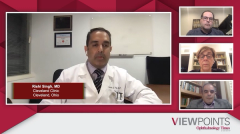
Emerging agents for the treatment of DR/DME
Emerging agents and therapies in the pipeline for the treatment of diabetic retinopathy and diabetic macular edema.
Episodes in this series

Rishi Singh, MD: We have a variety of different treatment options available to us, and there are some that are coming out. We can discuss limitations with the current treatment options and then talk about the newer agents that are here. Obviously, our limitations are that the frequency is high and that the burden is high. It is socioeconomically almost impossible for patients to get a full bevy of treatments, and we do the best we can, but there are other drugs that are becoming available. Dr Loewenstein, can you comment on faricimab as a start?
Anat Loewenstein, MD: First of all, I want to say a word about the burden. The burden is not only for the patient. Of course, for patients with diabetes, the burden is terrible because they have many other things that they need to do. They need to go to the podiatrist, they need to go to the cardiologist, and they need to go to other specialists. The burden on them, on the system, and of course on their caregivers is terrible, so we need to lower the burden somehow.
Faricimab is one of the most promising drugs. It is a drug that is bispecific. It is anti-ANG2 [angiopoietin 2]. ANG2 is a trigger in the Tie2 pathway to cause destabilization of the blood vessels. The drug also enhances the activity of VEGF. If you have a molecule that has elements of being both anti-ANG2 as well as anti-VEGF, it theoretically and pharmacologically has the potential to be a good option for our patients. We have preliminary studies, both on AMD [age-related macular degeneration] and on DME [diabetic macular edema] showing that the drug is effective. For DME, the efficacy was better than with the comparator. In AMD, the efficacy was similar. Regarding the duration in both phase 2 trials, when we looked at the second phase of the trial and looked the durability and the survival curve, when did the patient need another treatment, it had great potential when compared to the comparator.
Another important thing about faricimab is that, because it is anti-ANG2, it’s also anti-inflammatory. We know that it’s not the end, but at least in the studies, there wasn’t any issue with inflammatory response. With other drugs that are coming, such as brolucizumab, we have results from phase 3 trials on AMD in the form of the HAWK and HARRIER trials that showed a great benefit. Unfortunately, both in the trials and in the post-marketing surveillance, it has been established that about 4% of the patients developed an inflammatory reaction. In 1% of the patients, it can cause a significant abrupt decrease in visual acuity, and that’s for AMD.
For DME, we have the results for the KITE trial. I didn’t see the readout of the KESTREL trial yet, but I looked at the results for DME, and it again seems to be a promising drug. I’m worried about the inflammatory response. I know that the company is looking into it and trying to find the reason, the root cause, the risk factors, and the management options. Until then, it’s a bit problematic to use this drug.
Regarding KSI-301 and gene therapy, the data are promising, but it is not yet close to clinical use on a large scale. I’m not saying that it will not be. I hope that it will, but I’m not seeing it coming up that soon. Another option that I see coming up is the slow-release device, like the PDS [port delivery system]. We know that it’s now only being studied for diabetes, but for AMD we have pretty good results. There is a small issue of safety. We have to look into the cases of endophthalmitis there, but the rates will probably come down as we go through the learning curve, obviously. We have a lot of things coming up. We have to weigh the risks and the longer durability that we see coming up. I see faricimab as the most promising drug for the future.
Rishi Singh, MD: Dr Ferrucci and Dr Chous, you could speak about on the optometry side. If you had to look forward, thinking about some devices or technologies, what would make it much easier for you to do your work and help patients achieve the best possible outcomes for diabetic eye disease?
Steven G. Ferrucci, OD, FAAO: That’s a tough question. I don’t know. I’m not sure I can think of anything right now. Paul?
A. Paul Chous, MA, OD, FAAO: Something that I’ve been interested in is the retinal flavoproteins. It’s not specific to diabetes, but it’s the earliest marker of photoreceptor oxidative stress in diabetes, AMD, and in glaucoma they’ve even shown. I’m interested in that as an early marker in improving glucose control and improving those markers to keep the patients from needing to see the retina specialist. In optometry, my goal is to keep the patient from needing an injection in the eye or needing photocoagulation, if I possibly can. If there is anything with which I can detect disease earlier that’s easy to do and cost-effective, it appeals to me.
Rishi Singh, MD: Steve, do you have anything to add to that?
Steven G. Ferrucci, OD, FAAO: I would mention that there be more OCT [optical coherence tomography] imaging out there. With more accessibility to OCT imaging, that would be a great way to help monitor for diabetic macular edema. More affordability in OCT moving forward will help more optometrists have access to them, which should help take better care of patients and look for diabetic macular edema.
Rishi Singh, MD: I want to thank my panelists for today’s discussion, and thank you to the viewing audience for listening to the program. We hope you found this Viewpoints program to be rich and informative. We hope to see you soon.
A panel of experts in ophthalmology and optometry review the diagnosis and treatment of diabetic eye disease including emerging agents in the field.
Newsletter
Get the essential updates shaping the future of pharma manufacturing and compliance—subscribe today to Pharmaceutical Technology and never miss a breakthrough.








































